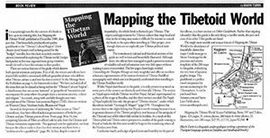Tibet &
Himalayas
Tibetan Cultural Region Directory
Tibet & Himalayas Message Board (BBS)
Art Gallery
Literary Award & Review
|
Extracts taken from the Nepali Times Review by Mark Turin #24, 5-11 January 2001 |
 |
"Mapping the Tibetoid World"
Mapping the Tibetan World. 1st Edition, December 2000, Kotan Publishing
424 pages, 21 colour photos, 286 black
& white
photos, 32 illustrations, over 280 maps.
ISBN 0-9701716-0-9.
It is surprisingly rare for the content of a book to live up to its enticing
title, but Mapping the Tibetan World, published in December 2000,
does just that. This beautifully produced and quality guidebook to the
'Tibetan Cultural Region' (their chosen term) brands itself as being suited
for the 'budget' traveller, but this claim is unduly modest: anyone interested
in exploring the Tibetan world, budget backpacker to five star organised
tour group member, would do well to have this volume in their pocket.
There are various features of the guide which deserve both special attention
and praise. First of all, the writers and editors have masterfully tackled
a notoriously difficult geopolitical issue: who defines what Tibetan culture
is and how far does it stretch? In the Message from the Publishers
on page 4, the framework is clear:
"We have included all of the areas that can be classed as being
within the 'Tibetan Cultural Region', a classification that cuts across
'national' or 'geopolitical' boundaries and encompasses the areas where
the people share a common ancestry, culture and religion."
As a result, along with carefully thought-out route descriptions of the
Tibetan Autonomous Region (TAR) there are sections on Western China, Northern
India, Bhutan and Nepal. 
The introductory cultural and historical sections of the guide are well written and beautifully illustrated. Although short, the editors have managed to pack a generous amount of valuable cultural information into very little space without making it seem overcrowded. The few pages charmingly entitled Unravelling the Thangka Message are truly insightful and offer an excellent schematic representation of the various elements of Tibetan Buddhist iconography with which one is so frequently confronted when travelling in the Tibetan Buddhist World.
The single most notable and unique feature of Mapping the Tibetan World is the abundance of beautifully-drawn line maps. Credit must go to Shozo Tominaga for the precision and artistic simplicity of the 280 maps in this guide, embodying the very best of Japanese graphic design. In short then, this guidebook is a perfect travel companion for anyone journeying in the Tibetosphere.
Mark Turin is a linguistic anthropologist writing a grammar of the Thangmi language spoken in Dolakha and Sindhupalcok. He is planning to publish a short Thangmi-Nepali-English word list in Kathmandu in 2001.
